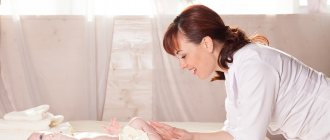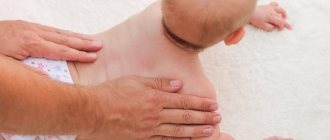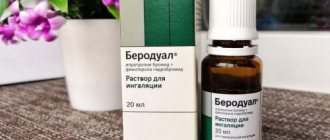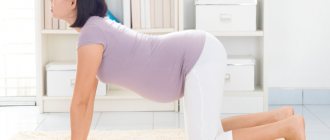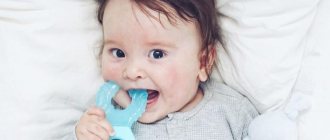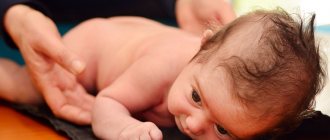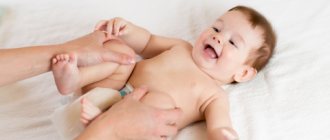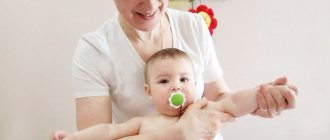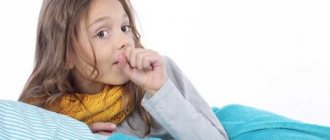We are used to treating our own colds with the magical “it will go away on its own” method. We continue to go to work, swallow packs of cough lozenges and drink tea with lemon. If a child is sick, jokes are put aside and treatment takes a serious turn. Children in the first years of life have a hard time suffering from respiratory infections. Even in the absence of fever, painful cough and difficulty breathing disrupt the sleep and appetite of babies. Percussion massage will help quickly cope with a child’s illness, a technique that every mother should master.
In young children, coughing occurs reflexively. More often it is superficial, not effective, and the child cannot yet specifically strengthen it. The mucous membranes of the bronchi are covered with viscous mucus, which makes breathing difficult and causes coughing.
The essence of percussion massage is rhythmic tapping of the chest. The vibration created by this leads to the separation of sputum from the walls of the bronchi.
In addition to mechanical separation of phlegm and easier breathing, percussion chest massage has other significant benefits:
- Distraction and general relaxation. Rhythmic tapping and stroking of the chest, coupled with a friendly tone and smile, will calm the child. Breathing will become deeper.
- Blood flow to internal organs. The heart is better supplied with oxygen and nutrients and works more efficiently.
- Blood supply to the pectoral, intercostal muscles and diaphragm. These muscles take part in the act of breathing. Therefore, increased muscle blood circulation leads to an increase in tidal volume. Ultimately, the child becomes more resilient and tolerates physical activity better.
What are the benefits of percussion massage?
Percussion massage is useful for children and adults. Frequent colds, chronic respiratory diseases, stress - these are the most common indications for percussion massage. Tapping improves blood circulation, makes breathing more efficient, relaxes the body, and helps saturate tissues and organs with oxygen.
For all its advantages, percussion massage is not an independent means of treating cough. It is used as prescribed by a doctor against the background of drug therapy. The effectiveness of chest tapping also depends on the patient’s drinking regime and living conditions. If your child has a cough and difficulty breathing, do wet cleaning daily, use a humidifier, and ventilate the room. It is better to refuse percussion massage if the baby’s body temperature is above 37°C
Additional cough techniques
In addition to percussion, there are several more specialized techniques used for bronchitis, pleurisy, etc. They can be prescribed as additional therapy for illness in combination with other massage techniques or carried out after recovery to improve respiratory functions.
Drainage
Massage procedures normalize breathing and help remove edematous fluid from the cavities and tissues of the body, which accumulates as a result of inflammatory processes. After tapping, there is an improvement in respiratory functions, an increase in the tone of the pectoral muscles and an increase in the displacement of the vertebrae of the thoracic spine during the breathing cycle.
Drainage technique for coughing
Massage is indicated for bronchitis, as well as for:
- Bronchial asthma;
- Pleurisy;
- Emphysema;
- Pneumonia.
You can start the session when the humidity level in the room is above 65%. A lower value will make it difficult for sputum to come out. The second condition for carrying out is the absence of inflammation in the respiratory organs and the patient’s body temperature is within normal limits. Failure to comply with these conditions can cause muscle spasms and phlegm retention in the bronchi.
How does massage affect a child's body?
Percussion massage is a painless and even pleasant procedure. You can turn the massage into a game by inviting your child to chant any vowel sounds. This way the course will be fun and the child will be looking forward to the next session. Tapping takes less than 5 minutes. From 3 to 6 such procedures can be performed per day. To relieve your baby from coughing, tap regularly for 10-15 days.
In addition to the treatment of respiratory diseases, percussion chest massage is used in orthopedics to correct postural disorders, for vegetative-vascular dystonia in adolescents, and also as rehabilitation after injuries.
Contraindications
Massage procedures are contraindicated in the following cases:
- during feverish conditions;
- patients who have a tendency to develop bleeding;
- persons with impaired integrity and infectious lesions of the skin;
- for thrombosis, thrombophlebitis, varicose veins of the second and higher stages;
- with an aneurysm;
- with severe vascular spasm, damage to the vascular walls;
- with severe atherosclerosis;
- for blood diseases;
- cancer patients;
- with damage to the lymph nodes;
- persons with mental pathologies;
- for urolithiasis and cholelithiasis (if a massage of the lower back and abdomen is planned);
- patients with active tuberculosis, AIDS, scurvy, osteomyelitis.
Tapping technique
Percussion massage is carried out on a hard surface at an air temperature of 22-25°C. It is better to do tapping before meals, but after a day or night sleep, when a large amount of sputum has accumulated in the bronchi. Calm your child down in advance and make sure his body temperature is not elevated.
Place the baby on his stomach and, if possible, extend his arms forward. Place a pillow under the abdomen and pelvis area so that the body is at an angle. This position will facilitate the release of viscous sputum. To prepare your baby for percussion massage, rub your baby's back for two minutes. After this, slightly bend the fingers of your hand and tap the tips intensively and often on the back, avoiding the kidney area. Position your fingers so that they point towards your head. Perform tapping for about a minute, then place the child in an upright position or sit down and allow him to cough. Lay your baby down again and continue tapping. One session consists of 4-5 such cycles. At the end of the procedure, rub the skin again.
Percussion massage can be performed on the back and sides of the chest. Breast tapping is also acceptable, but not required. During the procedure, monitor the child’s breathing and ask him not to hold his breath.
The percussion massage technique is simple to perform and does not require special knowledge or skills of a massage therapist. Every parent can master tapping. The procedure will not take much time, but will increase the effectiveness of cough treatment. Use percussion massage sessions to become even closer to your baby.
Massage after a stroke
Massage after a stroke at home at an affordable price is provided by specialists from the Yusupov Hospital. A team of rehabilitation clinic specialists (neurologists, rehabilitation specialists, kinesiotherapists) draws up an individual recovery program for a patient who has suffered a stroke. Massage at home is performed by an experienced massage therapist.
- The goals of massage after a stroke are as follows:
- improving blood flow and lymph outflow in the patient’s body;
- restoration of functions of the upper and lower extremities;
- preventing the formation of contractures (stiffness in joints);
- reduction of muscle spasms in the arms and legs;
- relief from pain and discomfort;
- increased muscle tone.
Massage helps prevent the formation of bedsores after an acute cerebrovascular accident. In the Yusupov Hospital, massage begins on the second day after a stroke attack, if the patient is conscious and the neurologist has not determined the presence of contraindications. Limb massage for ischemic stroke can be prescribed for 2-4 days. With a hemorrhagic stroke, it takes 6 to 8 days for scarring and restoration of blood flow.
At the beginning, the duration of the massage does not exceed 5 minutes, then another 5 minutes are added and by the end of the second week the sessions take at least 30 minutes. A massage course includes from 20 to 30 procedures. Then a break is taken for 1.5-2 months, after which they begin to consolidate the result. The techniques begin with impact on the upper joint of the limb: shoulder or thigh, then gradually move on to the rest of the arm and leg, massage the back and front surface of the chest, foot and hand.
Back massage is performed on the healthy side of the patient after a stroke. It is possible to place the patient on his stomach only in the absence of heart disease, disturbances in the functioning of internal organs, and only in the last stages of massage therapy. While the patient is in bed rest, it is advisable that the massage be performed by an experienced specialist. You can perform massage completely at home in the later stages of rehabilitation.
In order to achieve an effective result and reduce pain after a stroke, rehabilitation experts recommend adding auxiliary procedures to massage:
- a massager on a rigid base or a vibration-relaxation massager for recovery after a stroke;
- salt warmers;
- applications of paraffin, beeswax, ozokerite;
- massage oil or other fatty base to avoid tissue chafing.
After the massage, the patient should be wrapped in a warm blanket. Before starting massage procedures, it is recommended to warm up the limb area using warm-up circular movements. The massage therapist's hand passes should be carried out along the flow of lymph.
Massage is carried out using various movements:
- stroking;
- tapping;
- rubbing;
- light vibration.
Strong blows or “chopping” with the edge of the palm are not allowed, as they can cause muscle spasms. The patient after a stroke should not be subjected to excessive stress. It is important that the massage brings general relaxation and not painful sensations. Therefore, rehabilitation specialists recommend starting the massage with a healthy area around the affected limb. When using a massager, you should give compensating load to a healthy part of the body.
You can order a massage at home so that a specialist can teach massage techniques to people caring for a patient after a stroke. In this case, the price of a massage therapist at home will be different.
Benefits of massage for coughs
- strengthening the muscles of the back and chest involved in breathing;
- increasing the mobility of the ribs, in order to enhance their opening during inspiration;
- stabilizing breathing and indirectly enhancing the effect of medications;
- softening sputum and simplifying its outflow, this will normalize breathing and reduce the number of pathogens and foreign particles in the lungs.
Massage can be done only for wet coughs that occur with pneumonia, bronchitis, or colds. The session should be carried out at the end of the acute phase of the disease, that is, on the 4th or 5th day.
Drainage massage for children: basic movements
We stroke the intercostal muscles in the direction from the spine, without affecting the spinal column and the area of the shoulder blades. We alternate stroking with light rubbing. After a series of stroking and rubbing, we perform a light kneading.
The massage should be more intense, so the child may be a little capricious. We massage until the skin turns red. When the skin turns pink, we move on to vibrating movements. For vibrating movements, we use light tapping not with the edge of the palm, but with slightly relaxed fingers. You can also just tap with all your fingers, spreading them wide. We also perform light pats with the palm folded like a boat, creating a kind of light vacuum.
Massage for coughs in children: how to do drainage and percussion massage for sputum removal in the video
To understand when a child needs a massage when coughing, it is important to understand the manifestations of the disease:
- In the initial phase, while the inflammatory process is developing, the mucous membrane covering the bronchi is irritated and dry. A dry cough occurs, which is called non-productive. At this time, it is too early to do massage practices; there will be no benefit from them.
- On days 3-5, the cough becomes wet and productive: liquid discharge appears in the form of sputum. It's time to start a course of procedures.
- After the completion of the active phase of the disease and the cessation of coughing, it is recommended to continue the course of procedures for several more days.
Pediatricians recommend starting a course of cough treatments, in the absence of contraindications, as soon as the acute phase of the disease ends and the body temperature returns to normal (our review about suppositories for fever for children). Here are the main indications:
- complications after acute respiratory infections, flu;
- bronchitis, including COPD;
- some cases of pneumonia;
- pneumosclerosis;
- cystic fibrosis;
- remission during bronchial asthma.
The correct cough massage technique for children can significantly alleviate the condition during illness.
What happens as a result of well-performed manipulations:
- Bronchial mucus thins out and becomes more transportable.
- The movement and evacuation of sputum from the bronchi accelerates.
- Along with mucus, pathogenic microflora is removed from the body: bacteria, viruses, microorganisms.
- The mobility of the ribs increases, breathing and blood circulation in the chest are normalized.
- The effect of medications increases.
How does massage help remove mucus? With poor development of the respiratory muscles, coughing up sputum in children is difficult. Constant coughing irritates the throat, and coughing up phlegm becomes very painful.
As a result of massage manipulations, special cilia on the surface of the bronchial mucosa, designed to push mucus out, increase their activity. Stimulating blood circulation increases the production of bronchial secretions, which further thins the mucus.
Basic techniques
Classic techniques are designed for individual use or combination depending on the indication. General conditions to be observed:
- At least two hours should pass after eating.
- 30 minutes before the session, the child needs to take medications to thin the sputum.
- There should be no drafts in the room during the procedure; the air temperature should preferably be within 22-24 °C.
- After the session you cannot eat for about 1 hour.
Back massage
When coughing, the greatest effect is produced by manipulations in the upper and middle back. General principles:
- The patient's body is positioned so that the head is lower than the torso. This way, mucus can move freely through the respiratory tract.
- All movements of the massage therapist’s hands are directed from the lower back to the neck, that is, they create a “wave” of mucus movement towards the exit.
- At the end of the session you need to induce a cough.
- After the manipulations, it is advisable to cover the patient warmly.
Chest massage
The chest is massaged using circular, light movements. After the procedure, it is recommended to apply a warm compress, for example, a honey cake.
Additionally, the child's chest is massaged in the front part.
The patient is placed on his back. The upper part of the child's body is treated with circular rubbing, avoiding the area of the nipples, armpits and neck. The movements are directed upward, towards the neck.
After massage practice, it is advisable to apply a warm compress to the chest area.
Carry out the procedures 40 minutes before feeding the baby or 1.5 hours after it. The specialist's hands must be warm. It is advisable to create a pleasant atmosphere so that the child does not cry, otherwise the procedure will have to be interrupted. Sequencing:
- The child is placed with his tummy on a soft pillow.
- Using gentle finger movements, they stroke and lightly rub your back.
- When the skin turns pink, the baby is warmly wrapped and laid down.
By studying available and popular methods using videos and familiarizing yourself with different techniques, you can choose the optimal massage method for removing sputum in children. Once you learn how to do it yourself, you can successfully use these techniques when treating your children.
The body's goal is to get rid of phlegm, and the goal of treatment is to help it do this. I always recommend that mothers do drainage and honey massage for children over 3 years old when treating wet cough .
Once you learn how to do it, you can successfully use this skill for many years. Massage techniques not only help to cope with the disease faster, but also promotes the proper development of the child’s skeleton and muscles (on the issue of muscle hypotonia), improves posture, increases chest mobility, and increases immunity. The benefits of such procedures can hardly be overestimated.
Types of massage
| Child's age | Types and features of manipulations | Duration of procedures |
| Up to 3 months | Babies at this age are not prescribed massage | — |
| 3 months-1 year | Only a professional massage therapist can perform therapeutic procedures. The session consists of light stroking, rubbing and finger tapping. Be sure to use neutral oil for your baby's skin. | Up to 5 minutes, 1 time per day |
| 1-3 years | You can perform light vibration massage with caution, as well as honey massage - in the absence of an allergic reaction | 5 to 10 minutes, up to 2 times a day |
| 3-7 years | It is allowed to use percussion, drainage and honey techniques (without oil), and cupping techniques - with the use of neutral oils | 15-20 minutes, up to 3 times a day |
| Over 7 years old | All types of massage manipulations are allowed | 25 minutes, up to 4 times a day |
Vibrating (percussive)
An example of performing vibration chest massage for children is presented in the video. This simple method consists of repeatedly tapping the back with the edge of the palm in the direction from the middle of the back to the neck.
The implementation option that Dr. Komarovsky shows is tapping the fingers of a weakly clenched fist. The spine area is not treated. After the session, you need to invite the patient to cough well, moving him to an upright position.
Contraindications: in what cases the procedure cannot be performed
There are a number of restrictions for performing procedures in children. In addition to the acute phase of a respiratory or infectious disease, which is always a contraindication, there are the following risk factors:
- Heart diseases, including congenital defects.
- Diseases of the kidneys and liver in the acute phase.
- Allergic manifestations on the skin (see more about the types of rashes in a child).
- Asthma during an attack.
- Oncological diseases.
- Nervous system disorders.
- Body weight deficiency.
- Hernias.
About the TOP 12 antiviral drugs for children from 1 year old are written in this publication, and about the treatment of barking cough in this article.
From parents' reviews
Yulia, 33 years old, Podolsk, son 5 years old
During my son’s treatment for bronchoneumonia, I learned from my local doctor about the opportunity to undergo a course of special drainage massage at the clinic. After 10 sessions, the son began to sleep better, and the night coughing attacks gradually disappeared.
Of course, this was done at the very end of treatment, after a course of antibiotics and inhalations. But my baby liked the procedure, and now we often do it at home. The son himself comes up and asks to massage him!
Source: https://ipupsik.com/uhod-za-rebenkom/massazh-pri-kashle-u-detej.html
